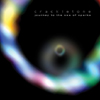 Jim Sutherland has quite a background as a composer of television andfilm scores. Crackletone is his somewhat minimalist, somewhat spooky,and somehow intriguing vehicle for composing drone-based pieces. I saythat the pieces are drone-based, but that really isn't fair: there area lot of different sounds used throughout the rather awkwardly namedalbum: what might be the sounds of a heart beating are combined withnauseating organ spills, a little too cleanly produced digital bleepsand bloops, and truly effective moans bubbling over with drifting windsand interstellar interference. The result of combining haunting andintriguing sounds with overused and bland ones makes for a see-sawexperience. At times the sounds really produce a sense of horror butthen they are interrupted by sounds that remind me that the horrificstuff can't possibly be real. In other words, what seems gritty, dirty,and realis revealed as fake because of sci-fi noises that remind me of blastersounds used in so many video games. The first track, "Crackletone," isa thirty-minute composition that manages to stay entrancing andbelievable despite some of the rather silly sounds used in it. "FondlePark" is nearly unlistenable. In fact, I only listened to it once andthat was only because I felt I had to so that I could be honest aboutthe album as a whole. "Journey to the Sea of Sparks" is probably thebest piece on the album, where a majority of those digital and cleansounds have been eliminated in favor of a rather stunning combinationof distorted grandfather clocks, evil hissing, and a truly strangemelody that appears half-way through and then disappears into the voidof space the rest of the sounds create. Maybe it's the sound of a stormas heard by someone on LSD or maybe its just the rumblings of aspace-monsters hungry stomach. In either case, it's entertaining. Ican't wholly reccomend this release, but I can't deny that I enjoy agood portion of it when I give it a spin; it's just that I don't oftenfeel compelled to listen to it.
Jim Sutherland has quite a background as a composer of television andfilm scores. Crackletone is his somewhat minimalist, somewhat spooky,and somehow intriguing vehicle for composing drone-based pieces. I saythat the pieces are drone-based, but that really isn't fair: there area lot of different sounds used throughout the rather awkwardly namedalbum: what might be the sounds of a heart beating are combined withnauseating organ spills, a little too cleanly produced digital bleepsand bloops, and truly effective moans bubbling over with drifting windsand interstellar interference. The result of combining haunting andintriguing sounds with overused and bland ones makes for a see-sawexperience. At times the sounds really produce a sense of horror butthen they are interrupted by sounds that remind me that the horrificstuff can't possibly be real. In other words, what seems gritty, dirty,and realis revealed as fake because of sci-fi noises that remind me of blastersounds used in so many video games. The first track, "Crackletone," isa thirty-minute composition that manages to stay entrancing andbelievable despite some of the rather silly sounds used in it. "FondlePark" is nearly unlistenable. In fact, I only listened to it once andthat was only because I felt I had to so that I could be honest aboutthe album as a whole. "Journey to the Sea of Sparks" is probably thebest piece on the album, where a majority of those digital and cleansounds have been eliminated in favor of a rather stunning combinationof distorted grandfather clocks, evil hissing, and a truly strangemelody that appears half-way through and then disappears into the voidof space the rest of the sounds create. Maybe it's the sound of a stormas heard by someone on LSD or maybe its just the rumblings of aspace-monsters hungry stomach. In either case, it's entertaining. Ican't wholly reccomend this release, but I can't deny that I enjoy agood portion of it when I give it a spin; it's just that I don't oftenfeel compelled to listen to it.samples:
Read More

